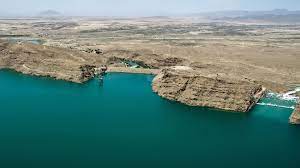The Iranian Foreign Minister Hossein Amir Abdollahian said that the countries’ shared history and culture could overcome any attempt by enemy forces to sour relations between Iran and Afghanistan. During his recent interview with the Iranian State News agency IRIB, the Iranian Foreign Minister stressed the importance of strengthening cooperation between the two neighbors by establishing border markets alongside the Afghan-Iran border. According to him, Iran will pursue its water rights from the Helmand River through legal and political means.
The bilateral relations between the Islamic Republic of Iran and the Islamic Emirate of Afghanistan had largely deteriorated over the past months because of the Helmand River’s water share dispute that flows from Afghanistan into eastern Iran.
On 27 May, border skirmishes broke out between security troops of both countries along the Afghan-Iran border which led to the killing of two Iranian border guards and one Taliban fighter and injuries to several others on both sides. The fighting comes amid rising tension between the two neighbors over the flow of water from the Helmand River about which the Iranian side complained that it did not receive its due share of water from Afghanistan. According to the statistics, over 90% of Iran’s population depends on the water it receives from the Helmand River for its agriculture and human consumption, while the country faced severe drought conditions since last year.
The Iranian side accused the Taliban government of violating the water accord, disregarding international law, and border protocol since the group gained power in Afghanistan about two years ago. Recently, President Ebrahim Raisi gave a stern warning to Afghan rulers to immediately give water rights to the Iranian people. Raisi’s statement attracted similar responses from various Taliban leaders, however, Islamic Emirate urged Iran to use diplomatic channels to resolve the water issue that has become a life-threatening phenomenon for both nations.
Historically, over 1000 kilometers long Helmand River flows from the Hindu Kush mountains through Afghanistan and enters Southeastern Iran. The river water had been crucial for irrigation, fishing, and human and household consumption for millions of people on both sides of the border in Afghanistan as well as Iran. According to the Helmand Water Treaty of 1973, Afghanistan has to annually share 850 million cubic meters of water with Iran. The water dispute had been a recurrent issue between the two neighbors throughout the past and both countries agreed on another water-sharing formula based on the previous accord in 2021. Afghanistan and Iran are water-deficient nations and face periods of water scarcity, and droughts that commonly inflamed tension between Kabul and Tehran. There are multiple environmental and metrological reasons for droughts in any nation, yet the construction of multiple dams on riverine could be the most legitimate reason for the reduction in the volume of water entering into a particular region.
The Iranian government is of the view that the construction of the Kajaki, Kamal Khan, and Selma dams on the Helmand River has reduced its water share and turned its country into a barren land. Therefore, the Iranian government strictly opposed the construction of dams and pressed Afghan rulers to abide by the water accords. Previously, a few purblind Afghan leaders had been advocating for the trading of water for oil with Iran which is a very insane and counterproductive strategy.
After the exchange of allegations, bullets, and bolts, both neighboring nations are currently in a diplomatic and border standoff, leaders are calling shots for dialogue and discussions to resolve water disputes. Water is essential for human survival and both nations face an acute dearth of precious Adam’s ale that is important for humans, animals, crop cultivation, and greenery. Water is a matter of concern for each country while the nations sitting upstream mostly claimed undue favor for their geographical locations from the communities located in the lower basin.
Pakistan also faces similar situations from Afghanistan and India regarding the river water entering through their territories. There is a dire need that the upstream nations to feel their responsibility under the global water convention and use water judiciously without causing problems for communities that lay in the downstream. As for Iran-Afghanistan is concerned both nations must use talks and diplomacy to resolve their issue as both nations face diplomatic isolation and their mutual hostility will further hurt their interest and support their enemies.







